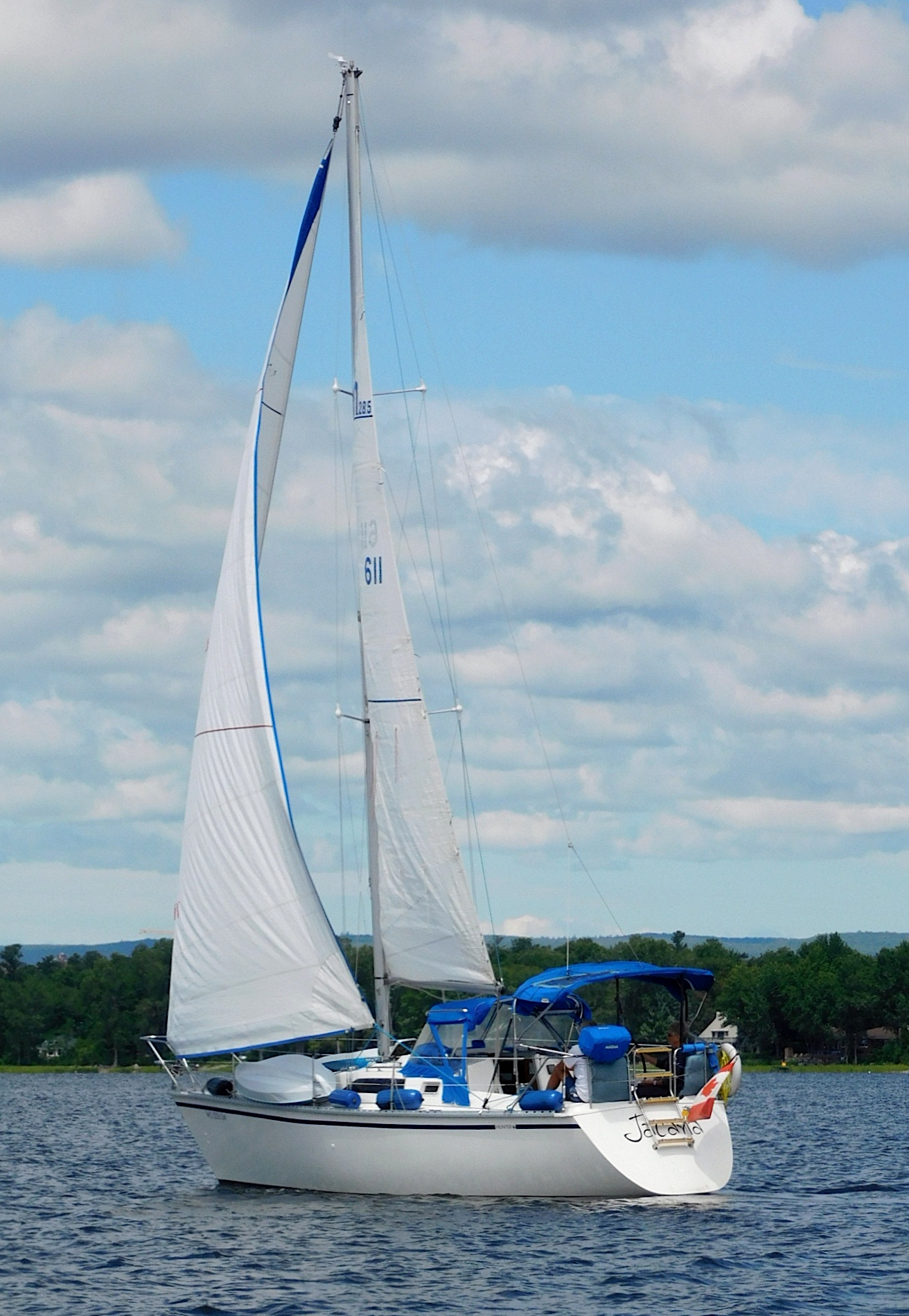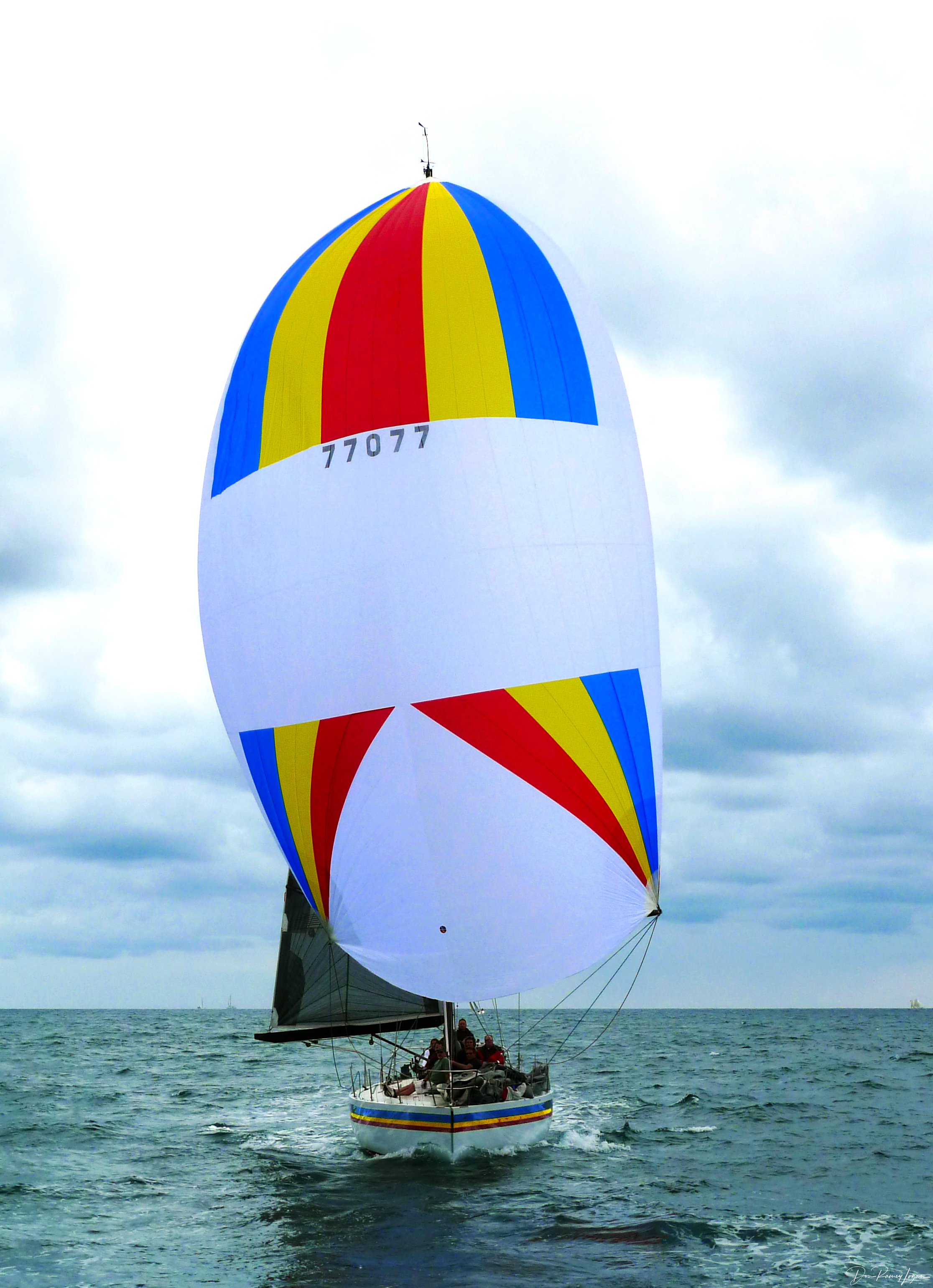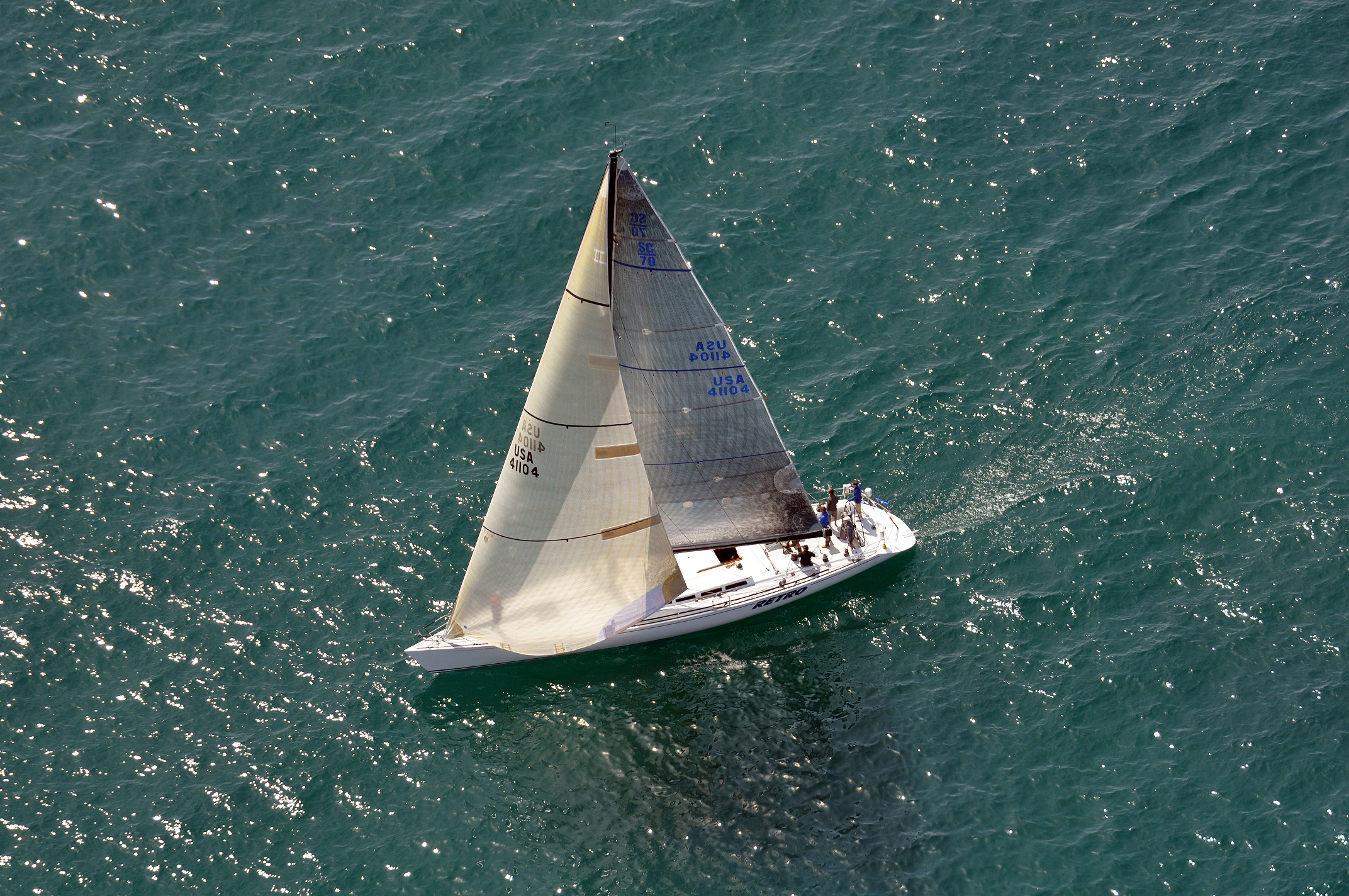|
Hunter 28.5
The Hunter 28.5 is an American sailboat that was designed by the Hunter Design Team and first built in 1985. The Hunter 28.5 was developed into the Hunter 28 in 1989. Production The design was built by Hunter Marine in the United States between 1985 and 1988, but it is now out of production. Design The Hunter 28.5 is a recreational keelboat, built predominantly of fiberglass, with wood trim. It is a B&R rigged sloop with a split backstay, with a raked stem, a reverse transom, an internally-mounted spade-type rudder controlled by a wheel and a fixed fin keel or shoal draft wing keel. The fin keel version displaces and carries of ballast, while the wing keel version displaces and carries of ballast. The boat has a draft of with the standard keel and with the optional shoal draft wing keel. The boat is fitted with an inboard diesel engine. The fuel tank holds and the fresh water tank has a capacity of . The factory-supplied standard equipment included a 110% genoa, ... [...More Info...] [...Related Items...] OR: [Wikipedia] [Google] [Baidu] |
Hunter Design Team
Hunter Marine is an American boat builder, now known as Marlow-Hunter, LLC, owned by David E. Marlow. The company also produces the Mainship powerboat brand. Marlow also owns and manufactures the Marlow Yachts brand consisting of long range power cruisers in the 37 to 110 foot range. The company is based in Alachua, Florida. The first boat design was a 25-foot (7.6 meter) long sloop, and another noted design was the Ocean racing sailboat the HC 50. History In the 1800s Henry Luhrs, a German immigrant, outfitted trading ships and owned a chandlery. His grandson, Henry, continued the family heritage on the New Jersey coast, building and repairing recreational and fishing boats. By the early 1960s Henry and his sons, John and Warren, were building over a thousand powerboats a year. Hunter was started in 1973 in Alachua, Florida, as a sailboat manufacturer. The early Hunter boats were designed by John E. Cherubini. In 1988 the company ran into trouble, as the founder, Lu ... [...More Info...] [...Related Items...] OR: [Wikipedia] [Google] [Baidu] |
Reverse Transom
A transom is the vertical reinforcement which strengthens the stern of a boat. This flat termination of the stern is typically above the waterline. The term was used as far back as Middle English in the 1300s, having come from Latin ''transversus'' (transverse) via Old French ''traversain'' (set crosswise). The stern of a boat is typically vertical. It can be raked such that there is an overhang above the water, as at the bow. A reverse transom is angled from the waterline forwards. Transoms can be used to support a rudder, outboard motor, or as a swimming and access platform. Gallery File:The Bermuda cedar (Juniperus bermudiana) transom of Spirit of Bermuda, 2016.jpg, The Bermuda cedar transom of the Spirit of Bermuda File:Sea Scooter transom.jpg, Flat transom on a dinghy with mount points for a rudder. File:Coble on shore at Boulmer (2) - geograph.org.uk - 1381157.jpg, Raked transom with rudder mount points. File:CS 30 Sailboat Kelsea 0297.jpg, Reverse transom with rudder ... [...More Info...] [...Related Items...] OR: [Wikipedia] [Google] [Baidu] |
Performance Handicap Racing Fleet
Performance Handicap Racing Fleet (PHRF) is a handicapping system used for yacht racing in North America. It allows dissimilar classes of sailboats to be raced against each other. The aim is to cancel out the inherent advantages and disadvantages of each class of boats, so that results reflect crew skill rather than equipment superiority. PHRF is used mainly for larger sailboats (i.e., 7 meters and above). For dinghy racing, the Portsmouth yardstick handicapping system is more likely to be used. The handicap number assigned to a class of yachts is based on the yacht's speed relative to a theoretical yacht with a rating of 0. A yacht's handicap, or rating, is the number of seconds per mile traveled that the yacht in question should be behind the theoretical yacht. Most boats have a positive PHRF rating, but some very fast boats have a negative PHRF rating. If Boat A has a PHRF rating of 15 and Boat B has a rating of 30 and they compete on a 1 mile course, Boat A should finish a ... [...More Info...] [...Related Items...] OR: [Wikipedia] [Google] [Baidu] |
Hull Speed
Hull speed or displacement speed is the speed at which the wavelength of a vessel's bow wave is equal to the waterline length of the vessel. As boat speed increases from rest, the wavelength of the bow wave increases, and usually its crest-to-trough dimension (height) increases as well. When hull speed is exceeded, a vessel in displacement mode will appear to be climbing up the back of its bow wave. From a technical perspective, at hull speed the bow and stern waves interfere constructively, creating relatively large waves, and thus a relatively large value of wave drag. Ship drag for a displacement hull increases smoothly with speed as hull speed is approached and exceeded, often with no noticeable inflection at hull speed. The concept of hull speed is not used in modern naval architecture, where considerations of speed/length ratio or Froude number are considered more helpful. Background As a ship moves in the water, it creates standing waves that oppose its movement. Thi ... [...More Info...] [...Related Items...] OR: [Wikipedia] [Google] [Baidu] |
Spinnaker
A spinnaker is a sail designed specifically for sailing off the wind on courses between a reach (wind at 90° to the course) to downwind (course in the same direction as the wind). Spinnakers are constructed of lightweight fabric, usually nylon, and are often brightly colored. They may be designed to perform best as either a reaching or a running spinnaker, by the shaping of the panels and seams. They are attached at only three points and said to be ''flown''. Nomenclature Informal names for a spinnaker are ''kite'' or ''chute'' (owing to their resemblance to a parachute in both construction and appearance). Boats may have more than one spinnaker, differentiated by a letter to indicate symmetric (S) or asymmetric (A) and a number to indicate size (with higher numbers indicating smaller size), e.g. ''A1'' would be a large asymmetric sail and ''S3'' would be a smaller symmetric sail. Operation A spinnaker is used for sailing with the direction of the wind. Symmetrical ... [...More Info...] [...Related Items...] OR: [Wikipedia] [Google] [Baidu] |
Anchor
An anchor is a device, normally made of metal , used to secure a vessel to the bed of a body of water to prevent the craft from drifting due to wind or current. The word derives from Latin ''ancora'', which itself comes from the Greek ἄγκυρα (ankȳra). Anchors can either be temporary or permanent. Permanent anchors are used in the creation of a mooring, and are rarely moved; a specialist service is normally needed to move or maintain them. Vessels carry one or more temporary anchors, which may be of different designs and weights. A sea anchor is a drag device, not in contact with the seabed, used to minimise drift of a vessel relative to the water. A drogue is a drag device used to slow or help steer a vessel running before a storm in a following or overtaking sea, or when crossing a bar in a breaking sea.. Overview Anchors achieve holding power either by "hooking" into the seabed, or mass, or a combination of the two. Permanent moorings use large masses (common ... [...More Info...] [...Related Items...] OR: [Wikipedia] [Google] [Baidu] |
Stainless Steel
Stainless steel is an alloy of iron that is resistant to rusting and corrosion. It contains at least 11% chromium and may contain elements such as carbon, other nonmetals and metals to obtain other desired properties. Stainless steel's corrosion resistance, resistance to corrosion results from the chromium, which forms a Passivation (chemistry), passive film that can protect the material and self-healing material, self-heal in the presence of oxygen. The alloy's properties, such as luster and resistance to corrosion, are useful in many applications. Stainless steel can be rolled into Sheet metal, sheets, plates, bars, wire, and tubing. These can be used in cookware, cutlery, surgical instruments, major appliances, vehicles, construction material in large buildings, industrial equipment (e.g., in paper mills, chemical plants, water treatment), and storage tanks and tankers for chemicals and food products. The biological cleanability of stainless steel is superior to both alumi ... [...More Info...] [...Related Items...] OR: [Wikipedia] [Google] [Baidu] |
Holly
''Ilex'' (), or holly, is a genus of over 570 species of flowering plants in the family Aquifoliaceae, and the only living genus in that family. ''Ilex'' has the most species of any woody dioecious angiosperm genus. The species are evergreen or deciduous trees, shrubs, and climbers from tropics to temperate zones worldwide. The type species is '' Ilex aquifolium'', the common European holly used in Christmas decorations and cards. Description The genus ''Ilex'' is divided into three subgenera: *''Ilex'' subg. ''Byronia'', with the type species ''Ilex polypyrena'' *''Ilex'' subg. ''Prinos'', with 12 species *''Ilex'' subg. ''Ilex'', with the rest of the species The genus is widespread throughout the temperate and subtropical regions of the world. It includes species of trees, shrubs, and climbers, with evergreen or deciduous foliage and inconspicuous flowers. Its range was more extended in the Tertiary period and many species are adapted to laurel forest habitats. It occurs ... [...More Info...] [...Related Items...] OR: [Wikipedia] [Google] [Baidu] |
Teak
Teak (''Tectona grandis'') is a tropical hardwood tree species in the family Lamiaceae. It is a large, deciduous tree that occurs in mixed hardwood forests. ''Tectona grandis'' has small, fragrant white flowers arranged in dense clusters (panicles) at the end of the branches. These flowers contain both types of reproductive organs ( perfect flowers). The large, papery leaves of teak trees are often hairy on the lower surface. Teak wood has a leather-like smell when it is freshly milled and is particularly valued for its durability and water resistance. The wood is used for boat building, exterior construction, veneer, furniture, carving, turnings, and other small wood projects. ''Tectona grandis'' is native to south and southeast Asia, mainly Bangladesh, India, Indonesia, Malaysia, Myanmar, Thailand and Sri Lanka, but is naturalised and cultivated in many countries in Africa and the Caribbean. Myanmar's teak forests account for nearly half of the world's naturally occurring teak. ... [...More Info...] [...Related Items...] OR: [Wikipedia] [Google] [Baidu] |
Genoa (sail)
A genoa sail is a type of large jib or staysail that extends past the mast and so overlaps the main sail when viewed from the side, sometimes eliminating it. It was originally called an "overlapping jib" and later a genoa jib. It is used on single-masted sloops and twin-masted boats such as yawls and ketches. Its larger surface area increases the speed of the craft in light to moderate winds; in high wind, a smaller jib is usually substituted, and downwind a spinnaker may be used. Definition The term ''jib'' is the generic term for any of an assortment of ''headsails''. The term ''genoa'' (or genny) refers to a type of jib that is larger than the 100% foretriangle, which is the triangular area formed by the point at which the stay intersects the mast, and deck or bowsprit, and the line where the mast intersects deck at the rail. Colloquially the term is sometimes used interchangeably with ''jib''. A working jib is no larger than the 100% foretriangle. A genoa is larger, with ... [...More Info...] [...Related Items...] OR: [Wikipedia] [Google] [Baidu] |
Diesel Engine
The diesel engine, named after Rudolf Diesel, is an internal combustion engine in which ignition of the fuel is caused by the elevated temperature of the air in the cylinder due to mechanical compression; thus, the diesel engine is a so-called compression-ignition engine (CI engine). This contrasts with engines using spark plug-ignition of the air-fuel mixture, such as a petrol engine (gasoline engine) or a gas engine (using a gaseous fuel like natural gas or liquefied petroleum gas). Diesel engines work by compressing only air, or air plus residual combustion gases from the exhaust (known as exhaust gas recirculation (EGR)). Air is inducted into the chamber during the intake stroke, and compressed during the compression stroke. This increases the air temperature inside the cylinder to such a high degree that atomised diesel fuel injected into the combustion chamber ignites. With the fuel being injected into the air just before combustion, the dispersion of the fuel is une ... [...More Info...] [...Related Items...] OR: [Wikipedia] [Google] [Baidu] |
Inboard Engine
Marine propulsion is the mechanism or system used to generate thrust to move a watercraft through water. While paddles and sails are still used on some smaller boats, most modern ships are propelled by mechanical systems consisting of an electric motor or internal combustion engine driving a propeller, or less frequently, in pump-jets, an impeller. Marine engineering is the discipline concerned with the engineering design process of marine propulsion systems. Human-powered paddles and oars, and later, sails were the first forms of marine propulsion. Rowed galleys, some equipped with sail, played an important early role in early human seafaring and warfares. The first advanced mechanical means of marine propulsion was the marine steam engine, introduced in the early 19th century. During the 20th century it was replaced by two-stroke or four-stroke diesel engines, outboard motors, and gas turbine engines on faster ships. Marine nuclear reactors, which appeared in the 1950s, produ ... [...More Info...] [...Related Items...] OR: [Wikipedia] [Google] [Baidu] |







